Role of Equality and Diversity in Workplace: AirDri Case Study
VerifiedAdded on 2023/01/11
|25
|4998
|55
Report
AI Summary
This report examines the significance of equality and diversity in minimizing the gender pay gap within the workplace, using AirDri as a case study. The research includes an introduction outlining the importance of employee contributions to organizational success, especially in today's competitive global market. The report details the aims and objectives of the research, focusing on analyzing the understanding of the equality act, examining existing policies at AirDri, and determining the advantages of building equality and diversity. A project management plan is presented, covering aspects like cost, scope, time, quality, communication, risk, and resources. The research methodology includes Gantt charts, Work Breakdown Structures (WBS), and both qualitative and quantitative data collection methods through questionnaires and primary/secondary sources. The report also includes a small-scale research section with sample questionnaires and discusses the importance of sampling. The report concludes with recommendations for AirDri based on the research findings and analysis.

Managing a Successful
Business Project
1
Business Project
1
Paraphrase This Document
Need a fresh take? Get an instant paraphrase of this document with our AI Paraphraser
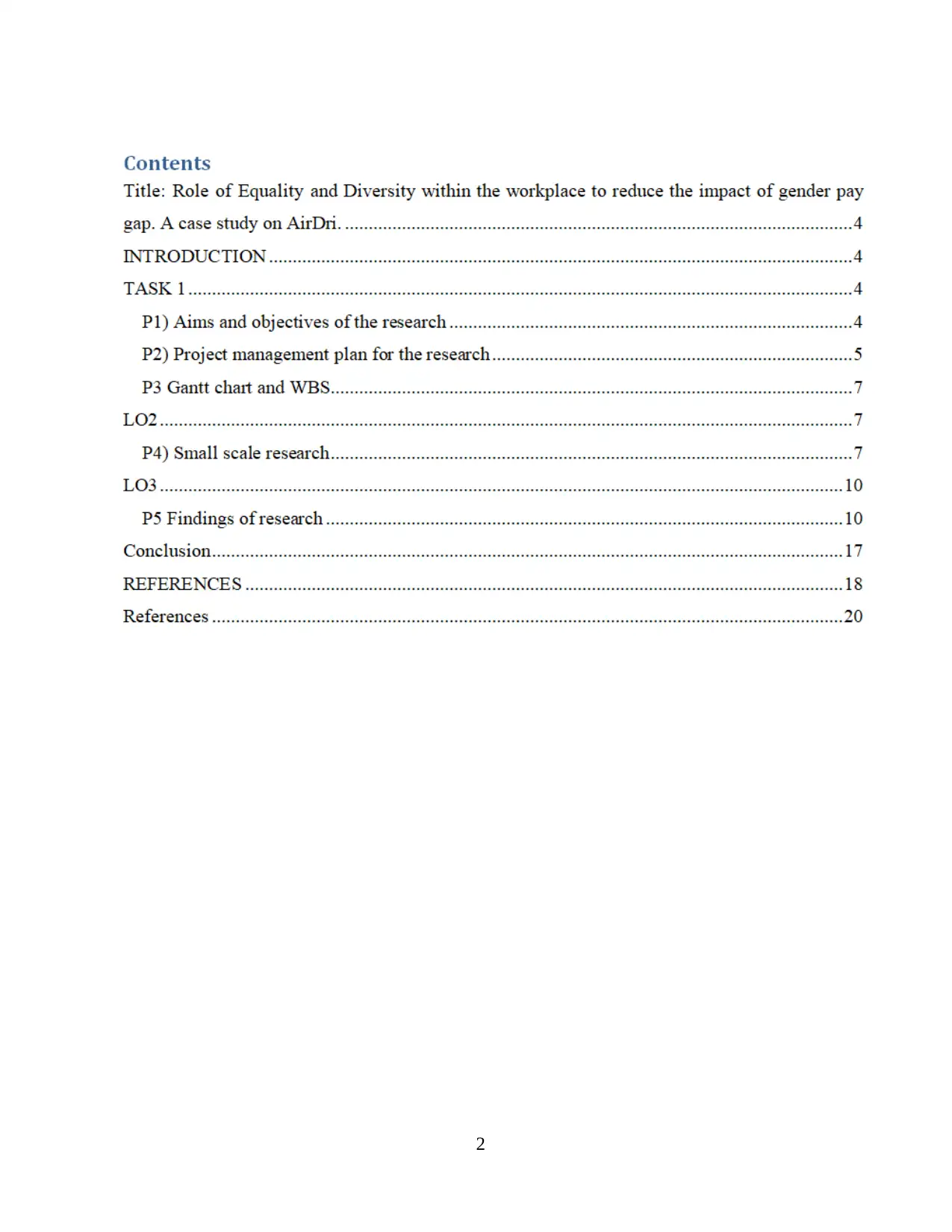
2
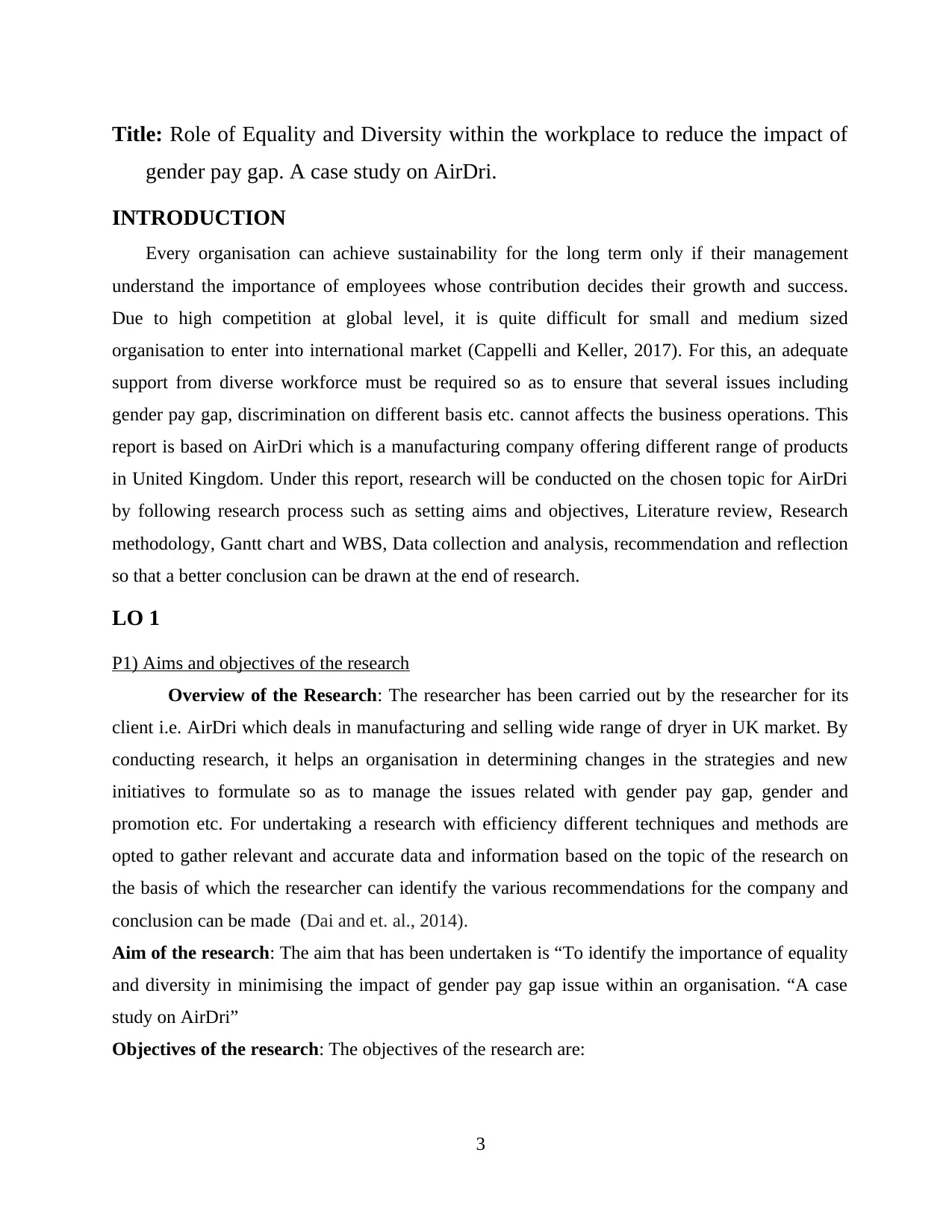
Title: Role of Equality and Diversity within the workplace to reduce the impact of
gender pay gap. A case study on AirDri.
INTRODUCTION
Every organisation can achieve sustainability for the long term only if their management
understand the importance of employees whose contribution decides their growth and success.
Due to high competition at global level, it is quite difficult for small and medium sized
organisation to enter into international market (Cappelli and Keller, 2017). For this, an adequate
support from diverse workforce must be required so as to ensure that several issues including
gender pay gap, discrimination on different basis etc. cannot affects the business operations. This
report is based on AirDri which is a manufacturing company offering different range of products
in United Kingdom. Under this report, research will be conducted on the chosen topic for AirDri
by following research process such as setting aims and objectives, Literature review, Research
methodology, Gantt chart and WBS, Data collection and analysis, recommendation and reflection
so that a better conclusion can be drawn at the end of research.
LO 1
P1) Aims and objectives of the research
Overview of the Research: The researcher has been carried out by the researcher for its
client i.e. AirDri which deals in manufacturing and selling wide range of dryer in UK market. By
conducting research, it helps an organisation in determining changes in the strategies and new
initiatives to formulate so as to manage the issues related with gender pay gap, gender and
promotion etc. For undertaking a research with efficiency different techniques and methods are
opted to gather relevant and accurate data and information based on the topic of the research on
the basis of which the researcher can identify the various recommendations for the company and
conclusion can be made (Dai and et. al., 2014).
Aim of the research: The aim that has been undertaken is “To identify the importance of equality
and diversity in minimising the impact of gender pay gap issue within an organisation. “A case
study on AirDri”
Objectives of the research: The objectives of the research are:
3
gender pay gap. A case study on AirDri.
INTRODUCTION
Every organisation can achieve sustainability for the long term only if their management
understand the importance of employees whose contribution decides their growth and success.
Due to high competition at global level, it is quite difficult for small and medium sized
organisation to enter into international market (Cappelli and Keller, 2017). For this, an adequate
support from diverse workforce must be required so as to ensure that several issues including
gender pay gap, discrimination on different basis etc. cannot affects the business operations. This
report is based on AirDri which is a manufacturing company offering different range of products
in United Kingdom. Under this report, research will be conducted on the chosen topic for AirDri
by following research process such as setting aims and objectives, Literature review, Research
methodology, Gantt chart and WBS, Data collection and analysis, recommendation and reflection
so that a better conclusion can be drawn at the end of research.
LO 1
P1) Aims and objectives of the research
Overview of the Research: The researcher has been carried out by the researcher for its
client i.e. AirDri which deals in manufacturing and selling wide range of dryer in UK market. By
conducting research, it helps an organisation in determining changes in the strategies and new
initiatives to formulate so as to manage the issues related with gender pay gap, gender and
promotion etc. For undertaking a research with efficiency different techniques and methods are
opted to gather relevant and accurate data and information based on the topic of the research on
the basis of which the researcher can identify the various recommendations for the company and
conclusion can be made (Dai and et. al., 2014).
Aim of the research: The aim that has been undertaken is “To identify the importance of equality
and diversity in minimising the impact of gender pay gap issue within an organisation. “A case
study on AirDri”
Objectives of the research: The objectives of the research are:
3
⊘ This is a preview!⊘
Do you want full access?
Subscribe today to unlock all pages.

Trusted by 1+ million students worldwide
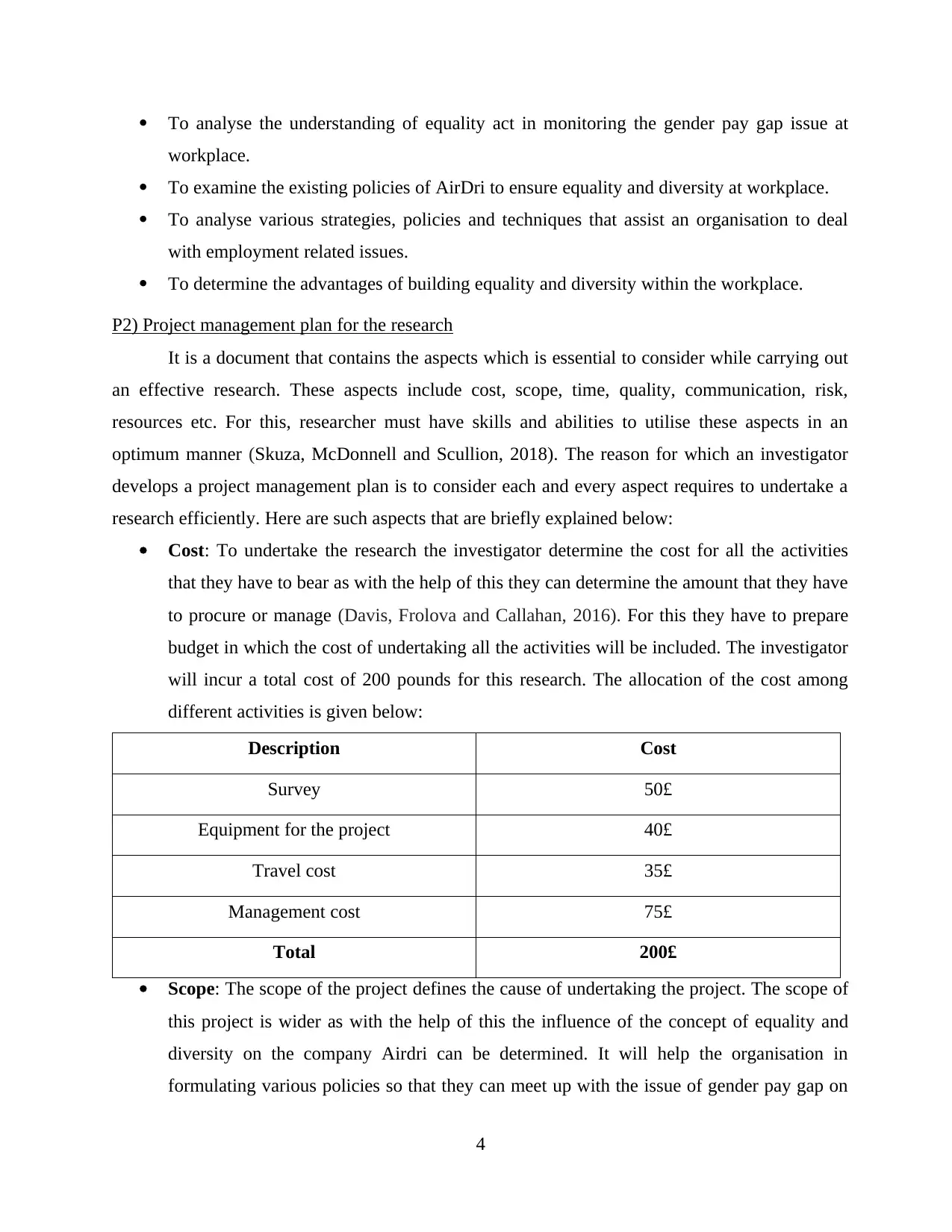
To analyse the understanding of equality act in monitoring the gender pay gap issue at
workplace.
To examine the existing policies of AirDri to ensure equality and diversity at workplace.
To analyse various strategies, policies and techniques that assist an organisation to deal
with employment related issues.
To determine the advantages of building equality and diversity within the workplace.
P2) Project management plan for the research
It is a document that contains the aspects which is essential to consider while carrying out
an effective research. These aspects include cost, scope, time, quality, communication, risk,
resources etc. For this, researcher must have skills and abilities to utilise these aspects in an
optimum manner (Skuza, McDonnell and Scullion, 2018). The reason for which an investigator
develops a project management plan is to consider each and every aspect requires to undertake a
research efficiently. Here are such aspects that are briefly explained below:
Cost: To undertake the research the investigator determine the cost for all the activities
that they have to bear as with the help of this they can determine the amount that they have
to procure or manage (Davis, Frolova and Callahan, 2016). For this they have to prepare
budget in which the cost of undertaking all the activities will be included. The investigator
will incur a total cost of 200 pounds for this research. The allocation of the cost among
different activities is given below:
Description Cost
Survey 50£
Equipment for the project 40£
Travel cost 35£
Management cost 75£
Total 200£
Scope: The scope of the project defines the cause of undertaking the project. The scope of
this project is wider as with the help of this the influence of the concept of equality and
diversity on the company Airdri can be determined. It will help the organisation in
formulating various policies so that they can meet up with the issue of gender pay gap on
4
workplace.
To examine the existing policies of AirDri to ensure equality and diversity at workplace.
To analyse various strategies, policies and techniques that assist an organisation to deal
with employment related issues.
To determine the advantages of building equality and diversity within the workplace.
P2) Project management plan for the research
It is a document that contains the aspects which is essential to consider while carrying out
an effective research. These aspects include cost, scope, time, quality, communication, risk,
resources etc. For this, researcher must have skills and abilities to utilise these aspects in an
optimum manner (Skuza, McDonnell and Scullion, 2018). The reason for which an investigator
develops a project management plan is to consider each and every aspect requires to undertake a
research efficiently. Here are such aspects that are briefly explained below:
Cost: To undertake the research the investigator determine the cost for all the activities
that they have to bear as with the help of this they can determine the amount that they have
to procure or manage (Davis, Frolova and Callahan, 2016). For this they have to prepare
budget in which the cost of undertaking all the activities will be included. The investigator
will incur a total cost of 200 pounds for this research. The allocation of the cost among
different activities is given below:
Description Cost
Survey 50£
Equipment for the project 40£
Travel cost 35£
Management cost 75£
Total 200£
Scope: The scope of the project defines the cause of undertaking the project. The scope of
this project is wider as with the help of this the influence of the concept of equality and
diversity on the company Airdri can be determined. It will help the organisation in
formulating various policies so that they can meet up with the issue of gender pay gap on
4
Paraphrase This Document
Need a fresh take? Get an instant paraphrase of this document with our AI Paraphraser
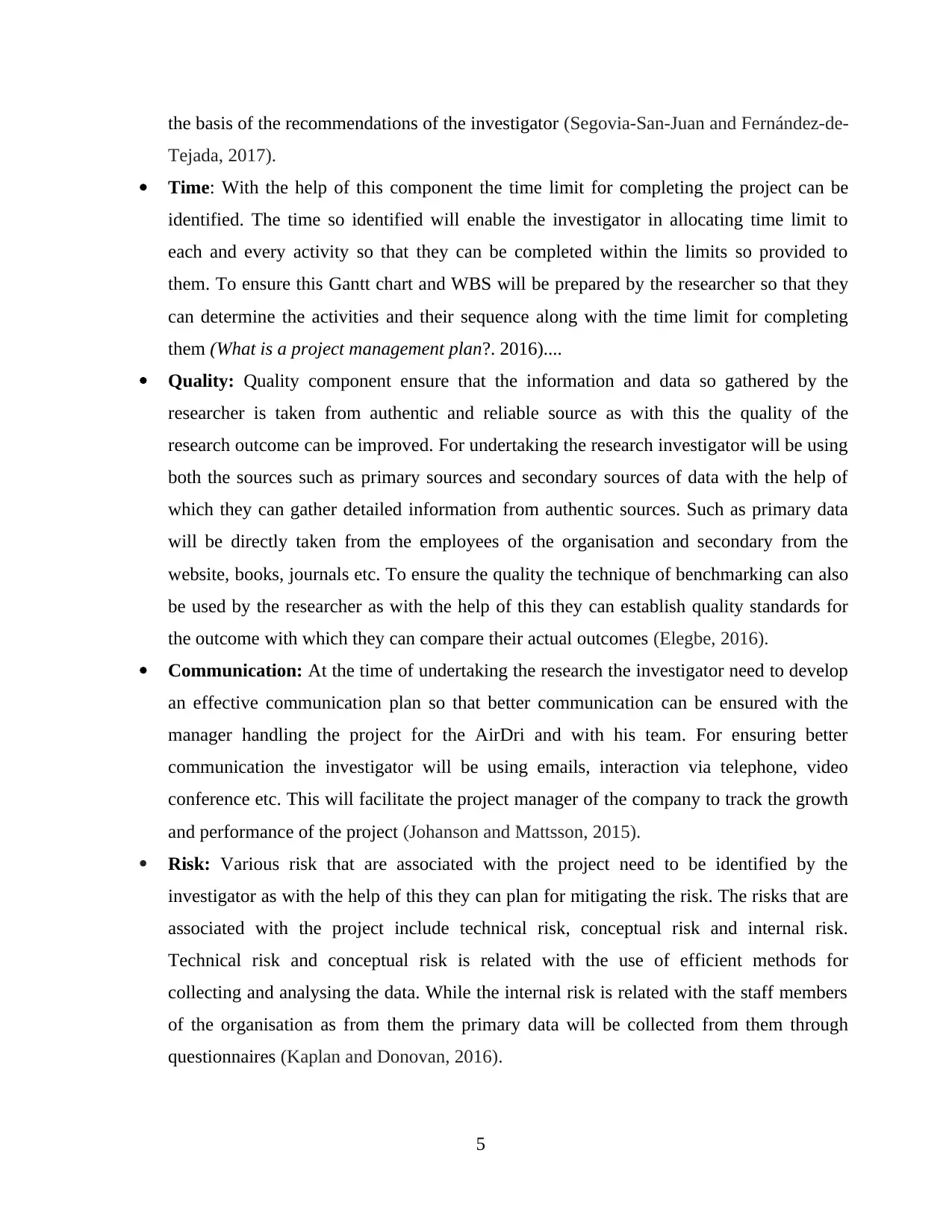
the basis of the recommendations of the investigator (Segovia-San-Juan and Fernández-de-
Tejada, 2017).
Time: With the help of this component the time limit for completing the project can be
identified. The time so identified will enable the investigator in allocating time limit to
each and every activity so that they can be completed within the limits so provided to
them. To ensure this Gantt chart and WBS will be prepared by the researcher so that they
can determine the activities and their sequence along with the time limit for completing
them (What is a project management plan?. 2016)....
Quality: Quality component ensure that the information and data so gathered by the
researcher is taken from authentic and reliable source as with this the quality of the
research outcome can be improved. For undertaking the research investigator will be using
both the sources such as primary sources and secondary sources of data with the help of
which they can gather detailed information from authentic sources. Such as primary data
will be directly taken from the employees of the organisation and secondary from the
website, books, journals etc. To ensure the quality the technique of benchmarking can also
be used by the researcher as with the help of this they can establish quality standards for
the outcome with which they can compare their actual outcomes (Elegbe, 2016).
Communication: At the time of undertaking the research the investigator need to develop
an effective communication plan so that better communication can be ensured with the
manager handling the project for the AirDri and with his team. For ensuring better
communication the investigator will be using emails, interaction via telephone, video
conference etc. This will facilitate the project manager of the company to track the growth
and performance of the project (Johanson and Mattsson, 2015).
Risk: Various risk that are associated with the project need to be identified by the
investigator as with the help of this they can plan for mitigating the risk. The risks that are
associated with the project include technical risk, conceptual risk and internal risk.
Technical risk and conceptual risk is related with the use of efficient methods for
collecting and analysing the data. While the internal risk is related with the staff members
of the organisation as from them the primary data will be collected from them through
questionnaires (Kaplan and Donovan, 2016).
5
Tejada, 2017).
Time: With the help of this component the time limit for completing the project can be
identified. The time so identified will enable the investigator in allocating time limit to
each and every activity so that they can be completed within the limits so provided to
them. To ensure this Gantt chart and WBS will be prepared by the researcher so that they
can determine the activities and their sequence along with the time limit for completing
them (What is a project management plan?. 2016)....
Quality: Quality component ensure that the information and data so gathered by the
researcher is taken from authentic and reliable source as with this the quality of the
research outcome can be improved. For undertaking the research investigator will be using
both the sources such as primary sources and secondary sources of data with the help of
which they can gather detailed information from authentic sources. Such as primary data
will be directly taken from the employees of the organisation and secondary from the
website, books, journals etc. To ensure the quality the technique of benchmarking can also
be used by the researcher as with the help of this they can establish quality standards for
the outcome with which they can compare their actual outcomes (Elegbe, 2016).
Communication: At the time of undertaking the research the investigator need to develop
an effective communication plan so that better communication can be ensured with the
manager handling the project for the AirDri and with his team. For ensuring better
communication the investigator will be using emails, interaction via telephone, video
conference etc. This will facilitate the project manager of the company to track the growth
and performance of the project (Johanson and Mattsson, 2015).
Risk: Various risk that are associated with the project need to be identified by the
investigator as with the help of this they can plan for mitigating the risk. The risks that are
associated with the project include technical risk, conceptual risk and internal risk.
Technical risk and conceptual risk is related with the use of efficient methods for
collecting and analysing the data. While the internal risk is related with the staff members
of the organisation as from them the primary data will be collected from them through
questionnaires (Kaplan and Donovan, 2016).
5
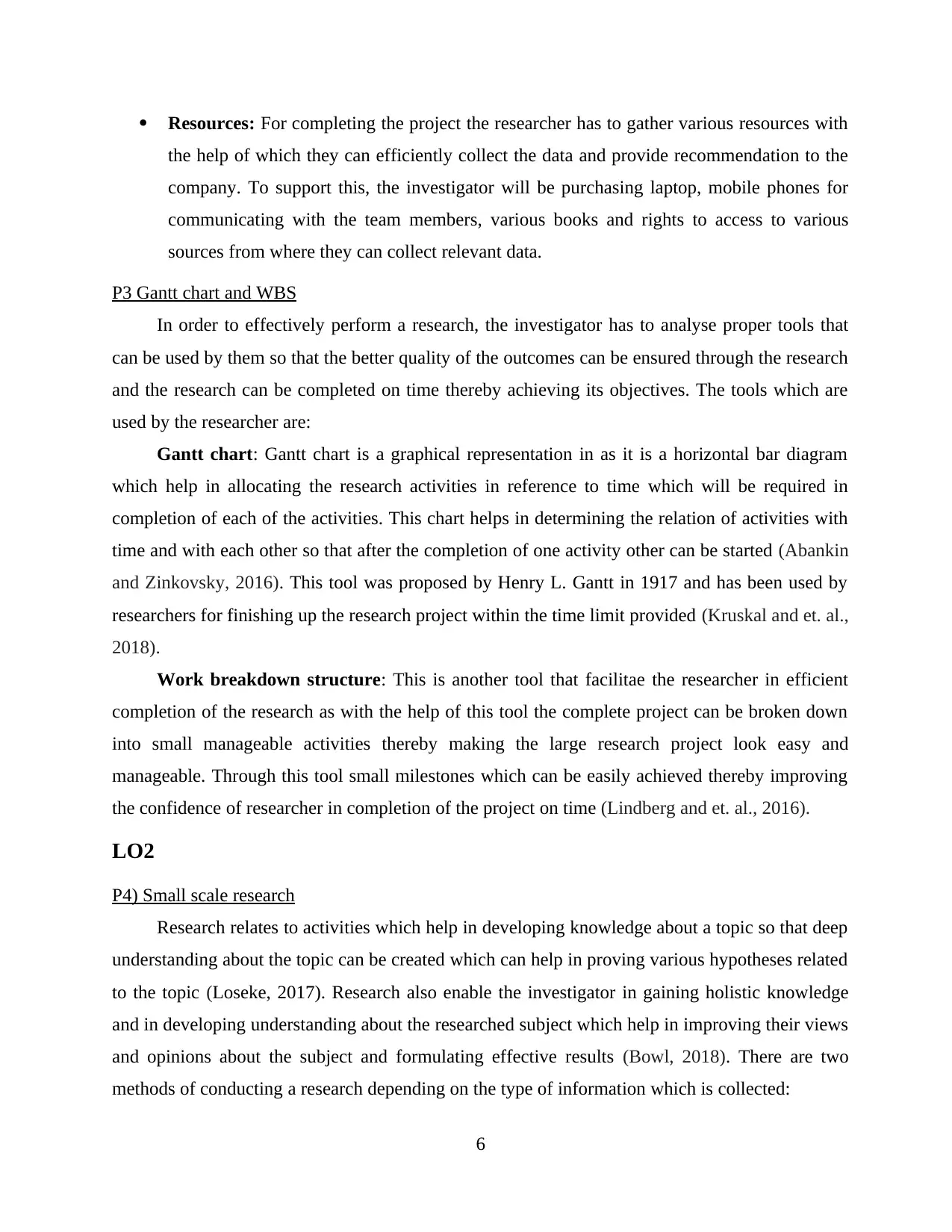
Resources: For completing the project the researcher has to gather various resources with
the help of which they can efficiently collect the data and provide recommendation to the
company. To support this, the investigator will be purchasing laptop, mobile phones for
communicating with the team members, various books and rights to access to various
sources from where they can collect relevant data.
P3 Gantt chart and WBS
In order to effectively perform a research, the investigator has to analyse proper tools that
can be used by them so that the better quality of the outcomes can be ensured through the research
and the research can be completed on time thereby achieving its objectives. The tools which are
used by the researcher are:
Gantt chart: Gantt chart is a graphical representation in as it is a horizontal bar diagram
which help in allocating the research activities in reference to time which will be required in
completion of each of the activities. This chart helps in determining the relation of activities with
time and with each other so that after the completion of one activity other can be started (Abankin
and Zinkovsky, 2016). This tool was proposed by Henry L. Gantt in 1917 and has been used by
researchers for finishing up the research project within the time limit provided (Kruskal and et. al.,
2018).
Work breakdown structure: This is another tool that facilitae the researcher in efficient
completion of the research as with the help of this tool the complete project can be broken down
into small manageable activities thereby making the large research project look easy and
manageable. Through this tool small milestones which can be easily achieved thereby improving
the confidence of researcher in completion of the project on time (Lindberg and et. al., 2016).
LO2
P4) Small scale research
Research relates to activities which help in developing knowledge about a topic so that deep
understanding about the topic can be created which can help in proving various hypotheses related
to the topic (Loseke, 2017). Research also enable the investigator in gaining holistic knowledge
and in developing understanding about the researched subject which help in improving their views
and opinions about the subject and formulating effective results (Bowl, 2018). There are two
methods of conducting a research depending on the type of information which is collected:
6
the help of which they can efficiently collect the data and provide recommendation to the
company. To support this, the investigator will be purchasing laptop, mobile phones for
communicating with the team members, various books and rights to access to various
sources from where they can collect relevant data.
P3 Gantt chart and WBS
In order to effectively perform a research, the investigator has to analyse proper tools that
can be used by them so that the better quality of the outcomes can be ensured through the research
and the research can be completed on time thereby achieving its objectives. The tools which are
used by the researcher are:
Gantt chart: Gantt chart is a graphical representation in as it is a horizontal bar diagram
which help in allocating the research activities in reference to time which will be required in
completion of each of the activities. This chart helps in determining the relation of activities with
time and with each other so that after the completion of one activity other can be started (Abankin
and Zinkovsky, 2016). This tool was proposed by Henry L. Gantt in 1917 and has been used by
researchers for finishing up the research project within the time limit provided (Kruskal and et. al.,
2018).
Work breakdown structure: This is another tool that facilitae the researcher in efficient
completion of the research as with the help of this tool the complete project can be broken down
into small manageable activities thereby making the large research project look easy and
manageable. Through this tool small milestones which can be easily achieved thereby improving
the confidence of researcher in completion of the project on time (Lindberg and et. al., 2016).
LO2
P4) Small scale research
Research relates to activities which help in developing knowledge about a topic so that deep
understanding about the topic can be created which can help in proving various hypotheses related
to the topic (Loseke, 2017). Research also enable the investigator in gaining holistic knowledge
and in developing understanding about the researched subject which help in improving their views
and opinions about the subject and formulating effective results (Bowl, 2018). There are two
methods of conducting a research depending on the type of information which is collected:
6
⊘ This is a preview!⊘
Do you want full access?
Subscribe today to unlock all pages.

Trusted by 1+ million students worldwide
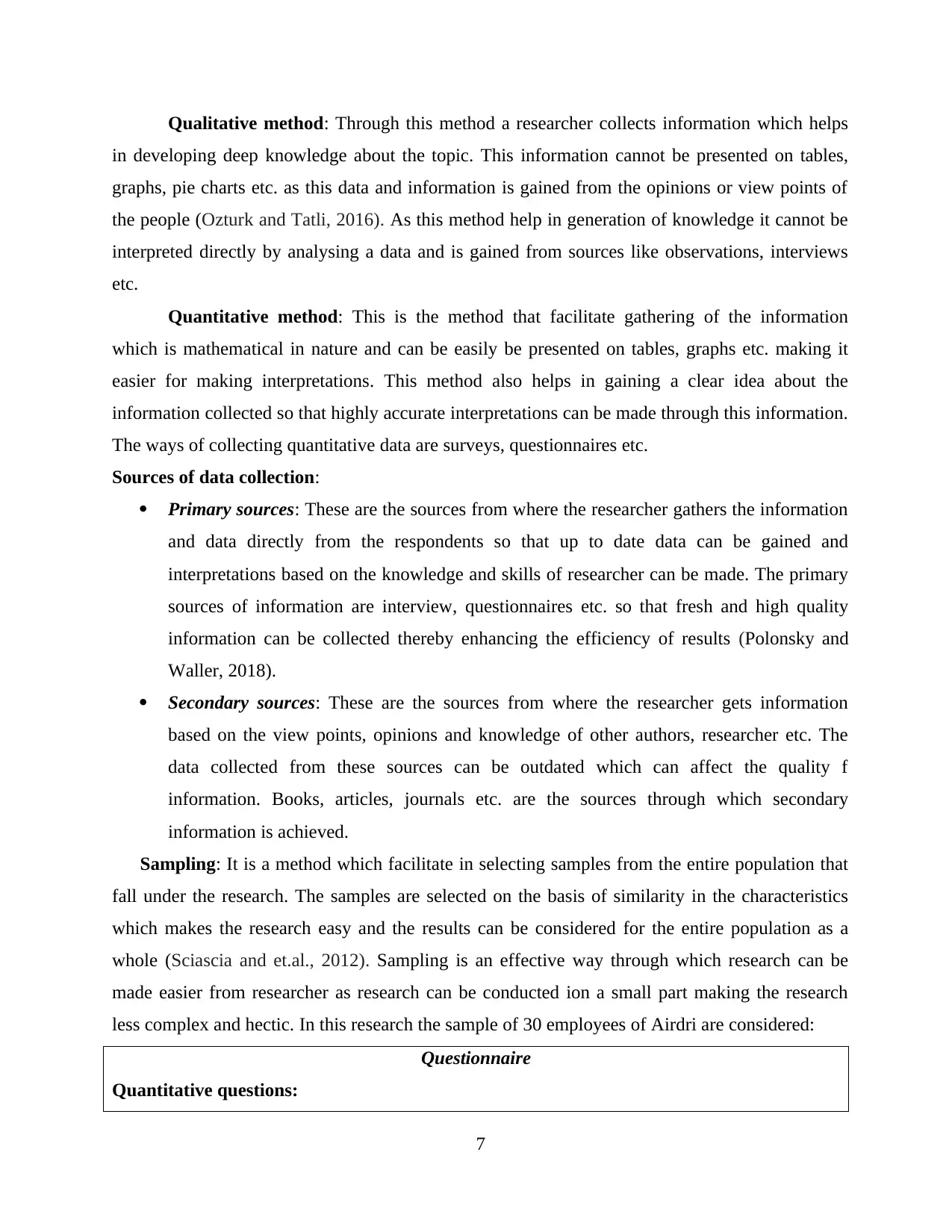
Qualitative method: Through this method a researcher collects information which helps
in developing deep knowledge about the topic. This information cannot be presented on tables,
graphs, pie charts etc. as this data and information is gained from the opinions or view points of
the people (Ozturk and Tatli, 2016). As this method help in generation of knowledge it cannot be
interpreted directly by analysing a data and is gained from sources like observations, interviews
etc.
Quantitative method: This is the method that facilitate gathering of the information
which is mathematical in nature and can be easily be presented on tables, graphs etc. making it
easier for making interpretations. This method also helps in gaining a clear idea about the
information collected so that highly accurate interpretations can be made through this information.
The ways of collecting quantitative data are surveys, questionnaires etc.
Sources of data collection:
Primary sources: These are the sources from where the researcher gathers the information
and data directly from the respondents so that up to date data can be gained and
interpretations based on the knowledge and skills of researcher can be made. The primary
sources of information are interview, questionnaires etc. so that fresh and high quality
information can be collected thereby enhancing the efficiency of results (Polonsky and
Waller, 2018).
Secondary sources: These are the sources from where the researcher gets information
based on the view points, opinions and knowledge of other authors, researcher etc. The
data collected from these sources can be outdated which can affect the quality f
information. Books, articles, journals etc. are the sources through which secondary
information is achieved.
Sampling: It is a method which facilitate in selecting samples from the entire population that
fall under the research. The samples are selected on the basis of similarity in the characteristics
which makes the research easy and the results can be considered for the entire population as a
whole (Sciascia and et.al., 2012). Sampling is an effective way through which research can be
made easier from researcher as research can be conducted ion a small part making the research
less complex and hectic. In this research the sample of 30 employees of Airdri are considered:
Questionnaire
Quantitative questions:
7
in developing deep knowledge about the topic. This information cannot be presented on tables,
graphs, pie charts etc. as this data and information is gained from the opinions or view points of
the people (Ozturk and Tatli, 2016). As this method help in generation of knowledge it cannot be
interpreted directly by analysing a data and is gained from sources like observations, interviews
etc.
Quantitative method: This is the method that facilitate gathering of the information
which is mathematical in nature and can be easily be presented on tables, graphs etc. making it
easier for making interpretations. This method also helps in gaining a clear idea about the
information collected so that highly accurate interpretations can be made through this information.
The ways of collecting quantitative data are surveys, questionnaires etc.
Sources of data collection:
Primary sources: These are the sources from where the researcher gathers the information
and data directly from the respondents so that up to date data can be gained and
interpretations based on the knowledge and skills of researcher can be made. The primary
sources of information are interview, questionnaires etc. so that fresh and high quality
information can be collected thereby enhancing the efficiency of results (Polonsky and
Waller, 2018).
Secondary sources: These are the sources from where the researcher gets information
based on the view points, opinions and knowledge of other authors, researcher etc. The
data collected from these sources can be outdated which can affect the quality f
information. Books, articles, journals etc. are the sources through which secondary
information is achieved.
Sampling: It is a method which facilitate in selecting samples from the entire population that
fall under the research. The samples are selected on the basis of similarity in the characteristics
which makes the research easy and the results can be considered for the entire population as a
whole (Sciascia and et.al., 2012). Sampling is an effective way through which research can be
made easier from researcher as research can be conducted ion a small part making the research
less complex and hectic. In this research the sample of 30 employees of Airdri are considered:
Questionnaire
Quantitative questions:
7
Paraphrase This Document
Need a fresh take? Get an instant paraphrase of this document with our AI Paraphraser
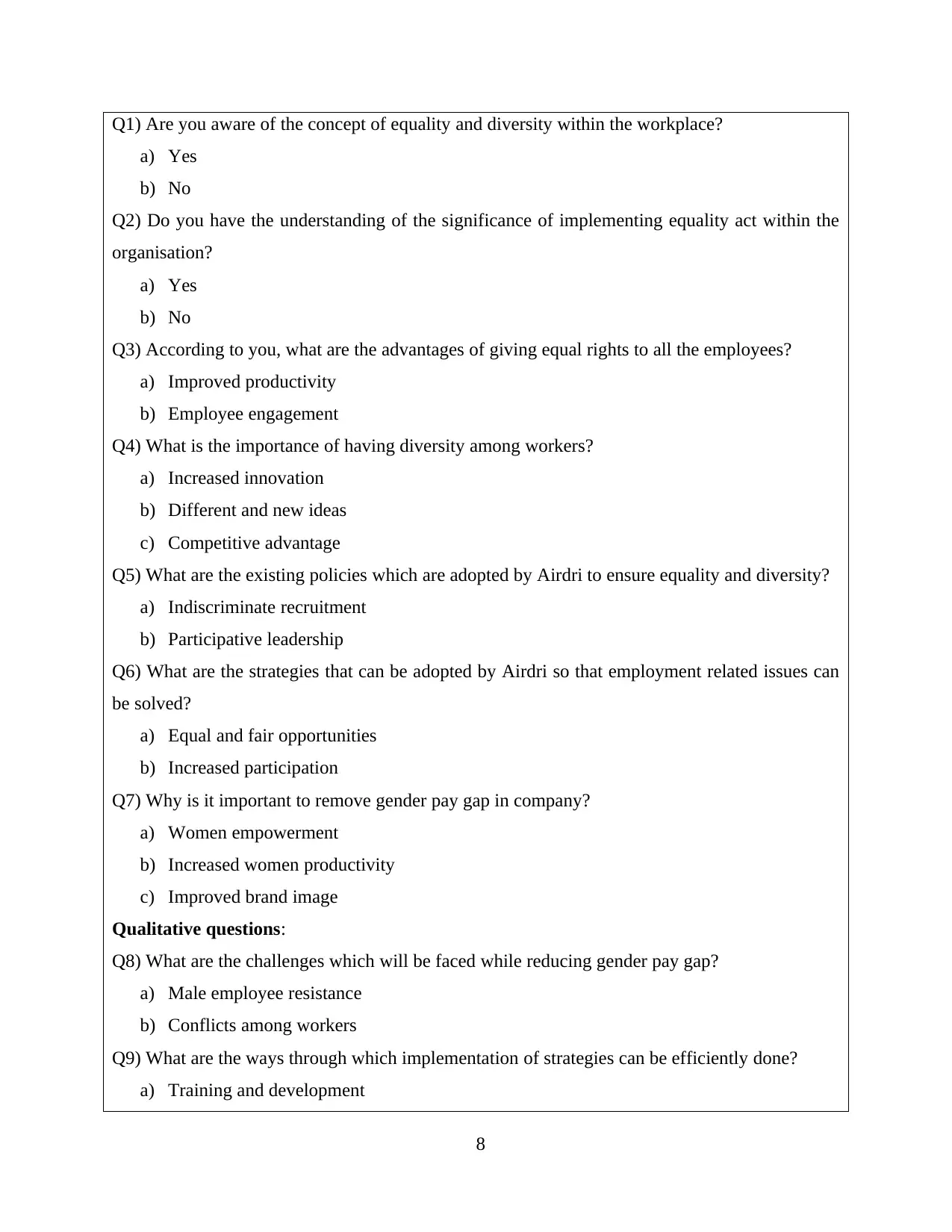
Q1) Are you aware of the concept of equality and diversity within the workplace?
a) Yes
b) No
Q2) Do you have the understanding of the significance of implementing equality act within the
organisation?
a) Yes
b) No
Q3) According to you, what are the advantages of giving equal rights to all the employees?
a) Improved productivity
b) Employee engagement
Q4) What is the importance of having diversity among workers?
a) Increased innovation
b) Different and new ideas
c) Competitive advantage
Q5) What are the existing policies which are adopted by Airdri to ensure equality and diversity?
a) Indiscriminate recruitment
b) Participative leadership
Q6) What are the strategies that can be adopted by Airdri so that employment related issues can
be solved?
a) Equal and fair opportunities
b) Increased participation
Q7) Why is it important to remove gender pay gap in company?
a) Women empowerment
b) Increased women productivity
c) Improved brand image
Qualitative questions:
Q8) What are the challenges which will be faced while reducing gender pay gap?
a) Male employee resistance
b) Conflicts among workers
Q9) What are the ways through which implementation of strategies can be efficiently done?
a) Training and development
8
a) Yes
b) No
Q2) Do you have the understanding of the significance of implementing equality act within the
organisation?
a) Yes
b) No
Q3) According to you, what are the advantages of giving equal rights to all the employees?
a) Improved productivity
b) Employee engagement
Q4) What is the importance of having diversity among workers?
a) Increased innovation
b) Different and new ideas
c) Competitive advantage
Q5) What are the existing policies which are adopted by Airdri to ensure equality and diversity?
a) Indiscriminate recruitment
b) Participative leadership
Q6) What are the strategies that can be adopted by Airdri so that employment related issues can
be solved?
a) Equal and fair opportunities
b) Increased participation
Q7) Why is it important to remove gender pay gap in company?
a) Women empowerment
b) Increased women productivity
c) Improved brand image
Qualitative questions:
Q8) What are the challenges which will be faced while reducing gender pay gap?
a) Male employee resistance
b) Conflicts among workers
Q9) What are the ways through which implementation of strategies can be efficiently done?
a) Training and development
8
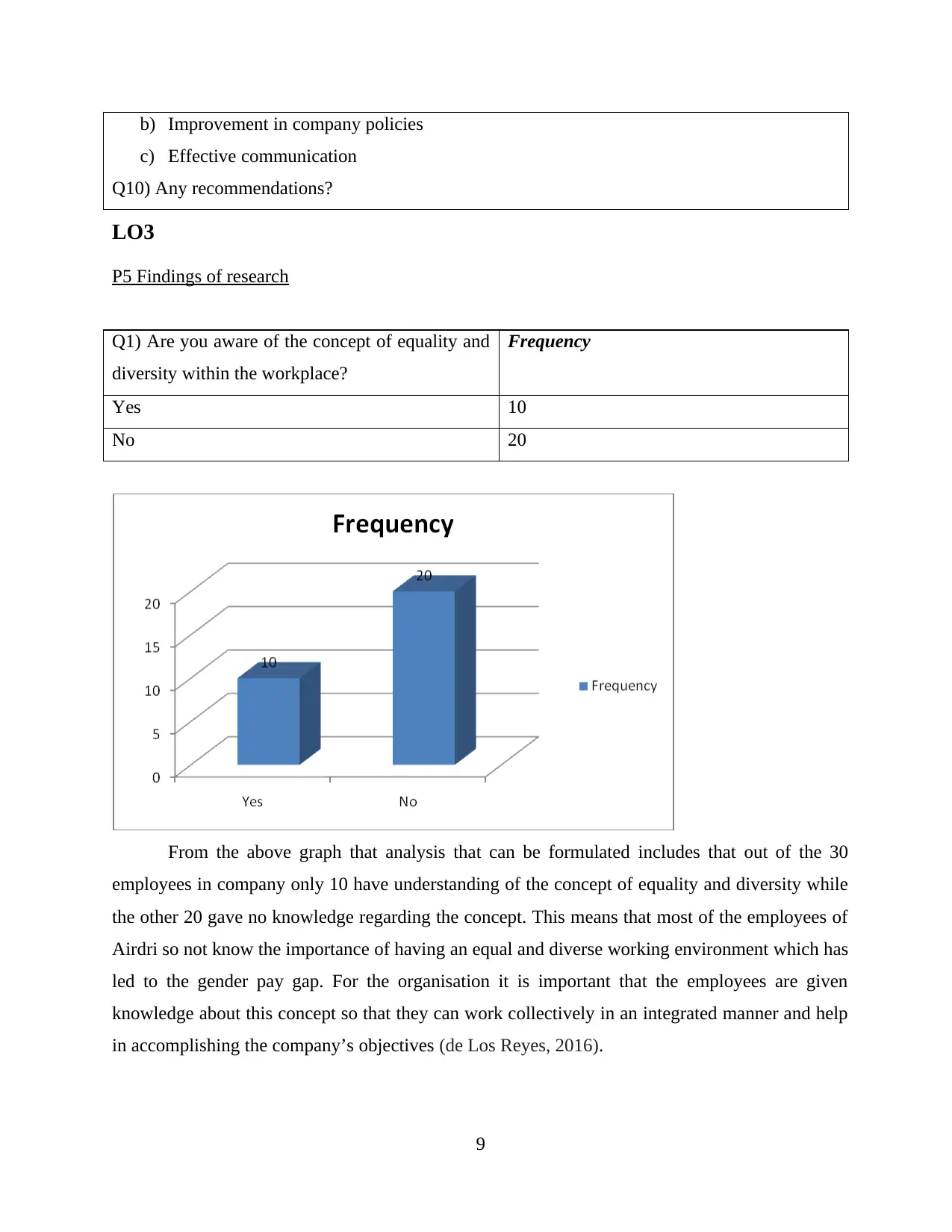
b) Improvement in company policies
c) Effective communication
Q10) Any recommendations?
LO3
P5 Findings of research
Q1) Are you aware of the concept of equality and
diversity within the workplace?
Frequency
Yes 10
No 20
From the above graph that analysis that can be formulated includes that out of the 30
employees in company only 10 have understanding of the concept of equality and diversity while
the other 20 gave no knowledge regarding the concept. This means that most of the employees of
Airdri so not know the importance of having an equal and diverse working environment which has
led to the gender pay gap. For the organisation it is important that the employees are given
knowledge about this concept so that they can work collectively in an integrated manner and help
in accomplishing the company’s objectives (de Los Reyes, 2016).
9
c) Effective communication
Q10) Any recommendations?
LO3
P5 Findings of research
Q1) Are you aware of the concept of equality and
diversity within the workplace?
Frequency
Yes 10
No 20
From the above graph that analysis that can be formulated includes that out of the 30
employees in company only 10 have understanding of the concept of equality and diversity while
the other 20 gave no knowledge regarding the concept. This means that most of the employees of
Airdri so not know the importance of having an equal and diverse working environment which has
led to the gender pay gap. For the organisation it is important that the employees are given
knowledge about this concept so that they can work collectively in an integrated manner and help
in accomplishing the company’s objectives (de Los Reyes, 2016).
9
⊘ This is a preview!⊘
Do you want full access?
Subscribe today to unlock all pages.

Trusted by 1+ million students worldwide
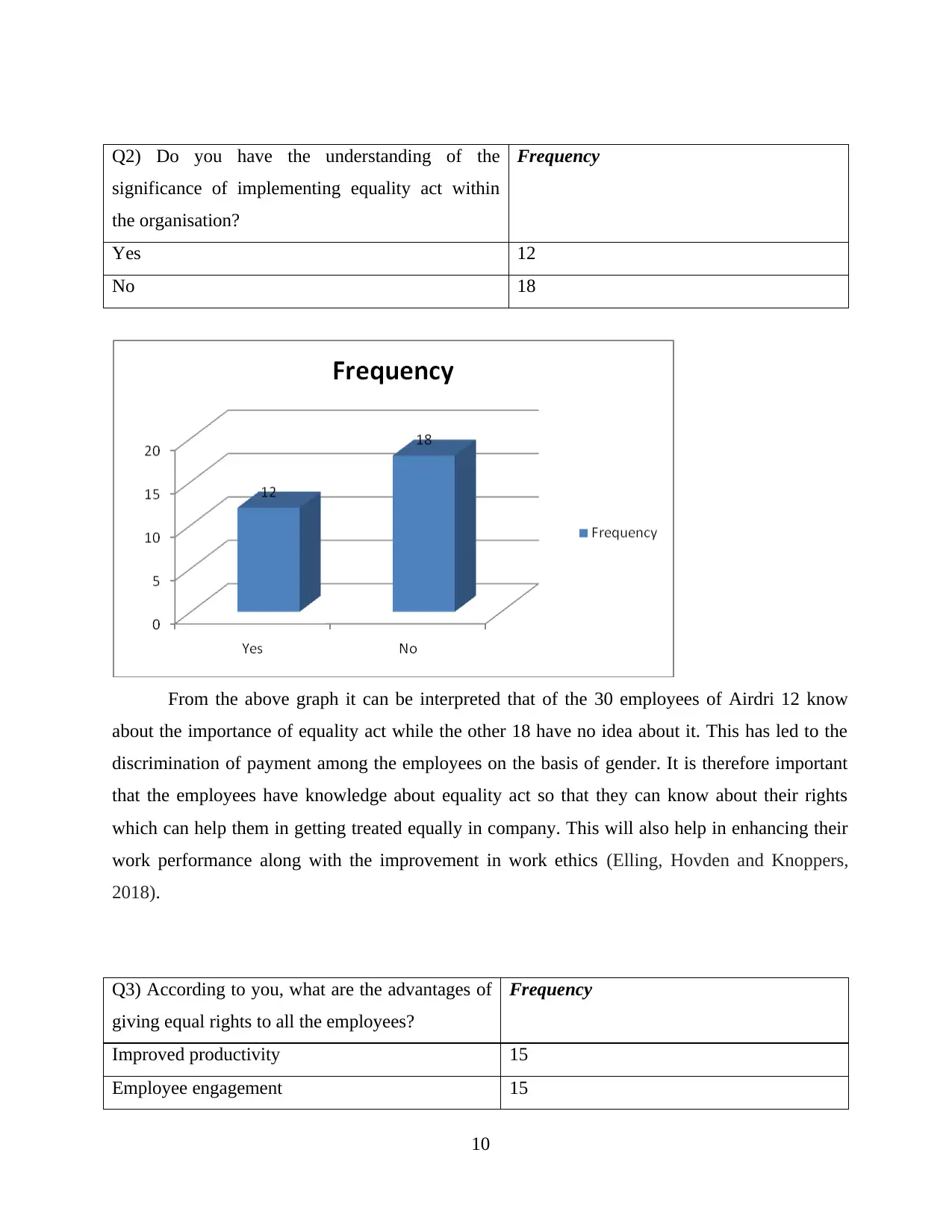
Q2) Do you have the understanding of the
significance of implementing equality act within
the organisation?
Frequency
Yes 12
No 18
From the above graph it can be interpreted that of the 30 employees of Airdri 12 know
about the importance of equality act while the other 18 have no idea about it. This has led to the
discrimination of payment among the employees on the basis of gender. It is therefore important
that the employees have knowledge about equality act so that they can know about their rights
which can help them in getting treated equally in company. This will also help in enhancing their
work performance along with the improvement in work ethics (Elling, Hovden and Knoppers,
2018).
Q3) According to you, what are the advantages of
giving equal rights to all the employees?
Frequency
Improved productivity 15
Employee engagement 15
10
significance of implementing equality act within
the organisation?
Frequency
Yes 12
No 18
From the above graph it can be interpreted that of the 30 employees of Airdri 12 know
about the importance of equality act while the other 18 have no idea about it. This has led to the
discrimination of payment among the employees on the basis of gender. It is therefore important
that the employees have knowledge about equality act so that they can know about their rights
which can help them in getting treated equally in company. This will also help in enhancing their
work performance along with the improvement in work ethics (Elling, Hovden and Knoppers,
2018).
Q3) According to you, what are the advantages of
giving equal rights to all the employees?
Frequency
Improved productivity 15
Employee engagement 15
10
Paraphrase This Document
Need a fresh take? Get an instant paraphrase of this document with our AI Paraphraser
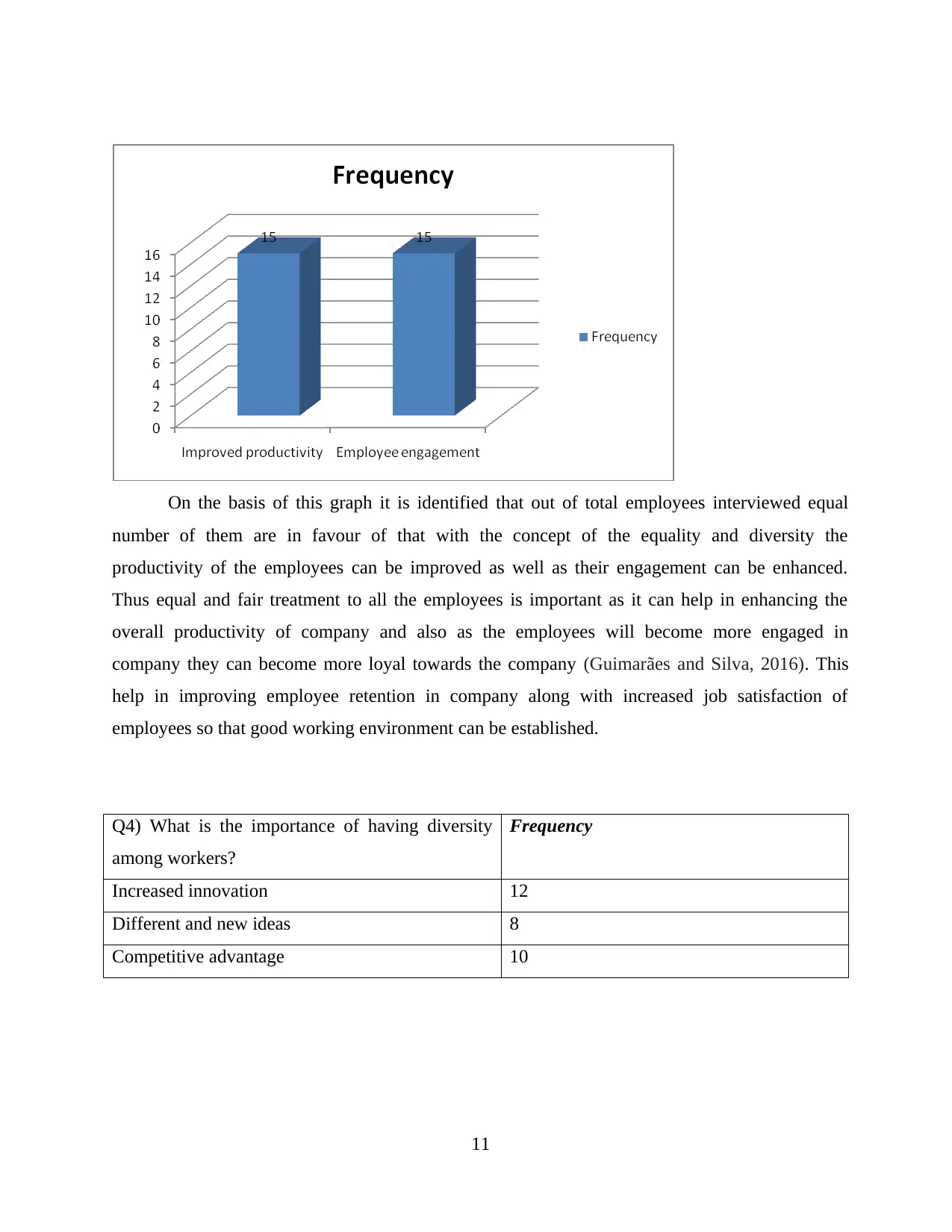
On the basis of this graph it is identified that out of total employees interviewed equal
number of them are in favour of that with the concept of the equality and diversity the
productivity of the employees can be improved as well as their engagement can be enhanced.
Thus equal and fair treatment to all the employees is important as it can help in enhancing the
overall productivity of company and also as the employees will become more engaged in
company they can become more loyal towards the company (Guimarães and Silva, 2016). This
help in improving employee retention in company along with increased job satisfaction of
employees so that good working environment can be established.
Q4) What is the importance of having diversity
among workers?
Frequency
Increased innovation 12
Different and new ideas 8
Competitive advantage 10
11
number of them are in favour of that with the concept of the equality and diversity the
productivity of the employees can be improved as well as their engagement can be enhanced.
Thus equal and fair treatment to all the employees is important as it can help in enhancing the
overall productivity of company and also as the employees will become more engaged in
company they can become more loyal towards the company (Guimarães and Silva, 2016). This
help in improving employee retention in company along with increased job satisfaction of
employees so that good working environment can be established.
Q4) What is the importance of having diversity
among workers?
Frequency
Increased innovation 12
Different and new ideas 8
Competitive advantage 10
11
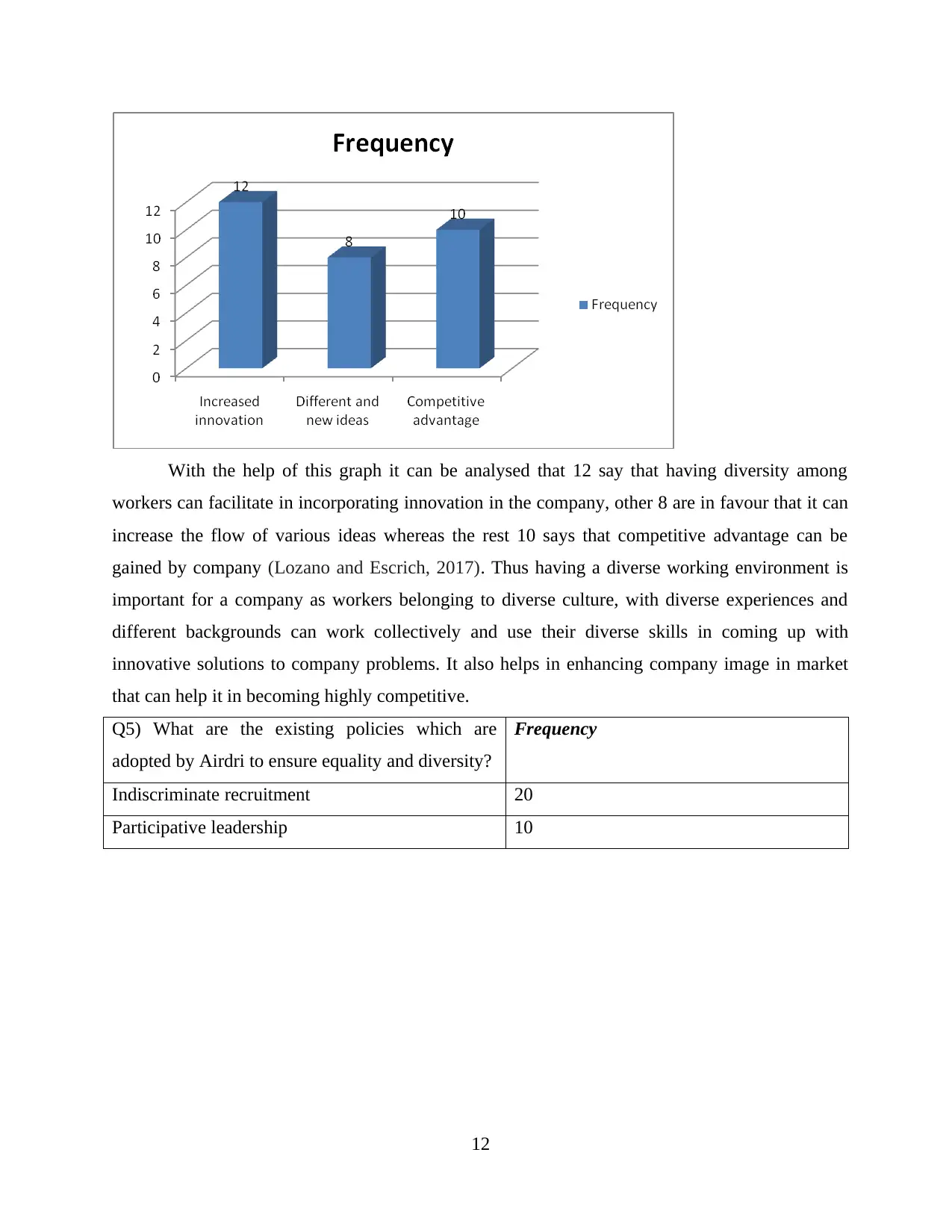
With the help of this graph it can be analysed that 12 say that having diversity among
workers can facilitate in incorporating innovation in the company, other 8 are in favour that it can
increase the flow of various ideas whereas the rest 10 says that competitive advantage can be
gained by company (Lozano and Escrich, 2017). Thus having a diverse working environment is
important for a company as workers belonging to diverse culture, with diverse experiences and
different backgrounds can work collectively and use their diverse skills in coming up with
innovative solutions to company problems. It also helps in enhancing company image in market
that can help it in becoming highly competitive.
Q5) What are the existing policies which are
adopted by Airdri to ensure equality and diversity?
Frequency
Indiscriminate recruitment 20
Participative leadership 10
12
workers can facilitate in incorporating innovation in the company, other 8 are in favour that it can
increase the flow of various ideas whereas the rest 10 says that competitive advantage can be
gained by company (Lozano and Escrich, 2017). Thus having a diverse working environment is
important for a company as workers belonging to diverse culture, with diverse experiences and
different backgrounds can work collectively and use their diverse skills in coming up with
innovative solutions to company problems. It also helps in enhancing company image in market
that can help it in becoming highly competitive.
Q5) What are the existing policies which are
adopted by Airdri to ensure equality and diversity?
Frequency
Indiscriminate recruitment 20
Participative leadership 10
12
⊘ This is a preview!⊘
Do you want full access?
Subscribe today to unlock all pages.

Trusted by 1+ million students worldwide
1 out of 25
Related Documents
Your All-in-One AI-Powered Toolkit for Academic Success.
+13062052269
info@desklib.com
Available 24*7 on WhatsApp / Email
![[object Object]](/_next/static/media/star-bottom.7253800d.svg)
Unlock your academic potential
Copyright © 2020–2025 A2Z Services. All Rights Reserved. Developed and managed by ZUCOL.





